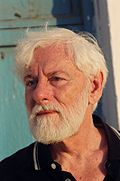THE NAME of Munib al-Masri has recently come up as a possible candidate for Prime Minister of a Palestinian national unity government. Not being a member of either Fatah or Hamas, he is acceptable to both.
Al-Masri himself denies any such ambition. He says that he is too old (77), and that a younger generation of Palestinians should take over.
He also says that he is quite content with his present situation.
And so would you be.
THE WEST BANK city of Nablus nestles in the valley between two tall mountains, Ebal and Gerizim. Mount Gerizim is the more famous one, because it is sacred to the Samaritan people, who believe that God commanded the Israelites to build his temple there. For them, Jerusalem is just an upstart.
Mount Gerizim, 881 meters above sea level, towers 330 meters above the center of Nablus. It is mentioned many times in the Bible. There Jotham, the son of the judge Gideon, made his famous speech comparing politicians to the bramble, a good-for-nothing plant that bears no fruit, has no scent and provides no shade, which agreed to be the king of the trees after all the other trees declined the honor. Perhaps Munib al-Masri agrees with this lesson, which seems strangely relevant in many countries today.
If you walk along the main street of Nablus and raise your eyes to heaven, you see on the top of the mountain an imposing building with a dome. This is the home of al-Masri.
Well, "home" may be slight understatement. Actually, it is the most imposing private residence in Palestine and Israel, if not -- as has been claimed -- from Morocco to the border of India.
The al-Masri villa is an exact reproduction of Villa Capra, also known as La Rotonda, a unique architectural masterpiece some 60 km from Venice. When you stand in front of the building, you can't believe your eyes. Actually, you don't even know where the front is -- because it has four "fronts," all with identical entrances, pillars and steps. When you enter through any one of them, you come to a wide circular foyer, from which all the rooms branch out. In the center stands an ancient Greek statue of Hercules. Over this three-floor-high central space towers the dome.
The marble for the floor and all the other building materials were brought from abroad. An Italian expert has joked that the Palestinian palace looks more like the original, and the Italian palazzo like a convincing copy.
That would have been more than enough. But it isn't.
All the rooms of the palace are crammed with works of art, collected by al-Masri over some 40 years. They are enough to fill an impressive museum. Paintings from renaissance masters to the moderns, fireplaces from Versailles, classic tables and chairs from Spain, Tapestries from Flanders, chandeliers from Italy, and much, much more. Room after room.
Well, that should be more than enough. But it isn't.
When excavation work for the foundation started, three small ancient pottery sherds were discovered. The work was stopped and archeological diggings began. The results were staggering: a complete 4th century Byzantine monastery was uncovered. It stands there now with all its rooms, chapels and stables, surrounded by stout pillars on which the entire modern structure rests. One building on top of another.
Enough? Not nearly. The palace is surrounded by a huge estate, greenhouses, olive plantations, a pool and whatnot. But enough of that.
I MET al-Masri, a slim, tall gentleman, some 20 years ago, on one of my visits to Yasser Arafat in Tunis. Al-Masri belonged to the inner circle of the leader, and returned to Palestine with him.
(Note: You can view every article as one long page if you sign up as an Advocate Member, or higher).





